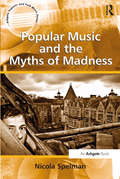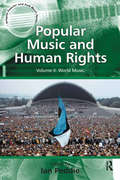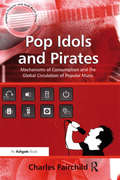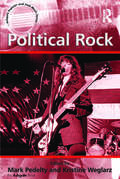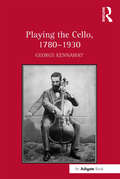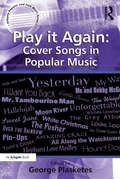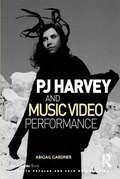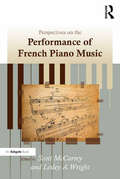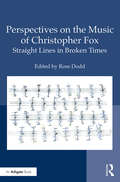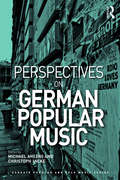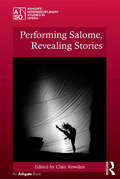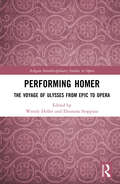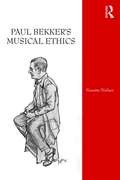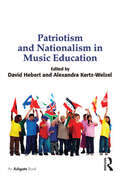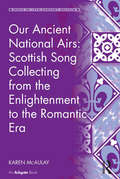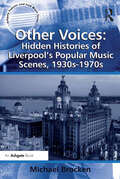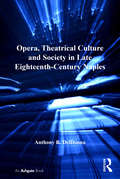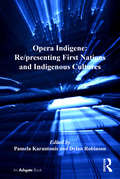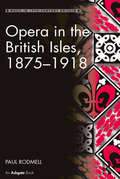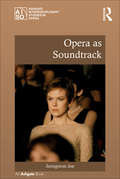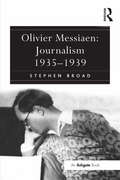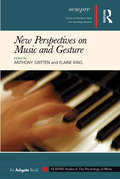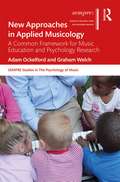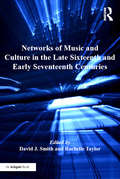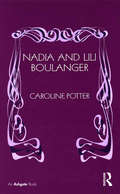- Table View
- List View
Popular Music and the Myths of Madness (Ashgate Popular and Folk Music Series)
by Nicola SpelmanStudies of opera, film, television, and literature have demonstrated how constructions of madness may be referenced in order to stigmatise but also liberate protagonists in ways that reinforce or challenge contemporaneous notions of normality. But to date very little research has been conducted on how madness is represented in popular music. In an effort to redress this imbalance, Nicola Spelman identifies links between the anti-psychiatry movement and representations of madness in popular music of the 1960s and 1970s, analysing the various ways in which ideas critical of institutional psychiatry are embodied both verbally and musically in specific songs by David Bowie, Lou Reed, Pink Floyd, Alice Cooper, The Beatles, and Elton John. She concentrates on meanings that may be made at the point of reception as a consequence of ideas about madness that were circulating at the time. These ideas are then linked to contemporary conventions of musical expression in order to illustrate certain interpretative possibilities. Supporting evidence comes from popular musicological analysis - incorporating discourse analysis and social semiotics - and investigation of socio-historical context. The uniqueness of the period in question is demonstrated by means of a more generalised overview of songs drawn from a variety of styles and eras that engage with the topic of madness in diverse and often conflicting ways. The conclusions drawn reveal the extent to which anti-psychiatric ideas filtered through into popular culture, offering insights into popular music's ability to question general suppositions about madness alongside its potential to bring issues of men's madness into the public arena as an often neglected topic for discussion.
Popular Music and Human Rights: World Music
by Ian PeddiePopular music has long understood that human rights, if attainable at all, involve a struggle without end. The right to imagine an individual will, the right to some form of self-determination and the right to self-legislation have long been at the forefront of popular music's approach to human rights. At a time of such uncertainty and confusion, with human rights currently being violated all over the world, a new and sustained examination of cultural responses to such issues is warranted. In this respect music, which is always produced in a social context, is an extremely useful medium; in its immediacy music has a potency of expression whose reach is long and wide. Contributors to this significant volume cover artists and topics such as Billy Bragg, punk, Fun-da-Mental, Willie King and the Liberators, Hedwig and the Angry Inch, the Anti-Death Penalty movement, benefit concerts, benefit albums, Gil Scott-Heron, Bruce Springsteen, Wounded Knee and Native American political resistance, Tori Amos, Joni Mitchell, as well as human rights in relation to feminism. A second volume covers World Music.
Pop Idols and Pirates: Mechanisms of Consumption and the Global Circulation of Popular Music (Ashgate Popular and Folk Music Series)
by Charles FairchildThe music industry has been waging some very significant battles in recent years, reacting to numerous inter-related crises provoked by globalization, digitalization and the ever more extensive commercialization of public culture. These struggles are viewed by many as central to the survival of the central mediators in the consumption of popular music. These battles are not just against piracy and the sharing of digital song files on the internet. The music industry is also struggling to find ways to compete or integrate with many other forms of entertainment, including films, television programmes, mobile phones, DVDs and video games in an extremely crowded communications environment. The battles currently being fought by the music industry are about nothing less than its continued ability to create and maintain specific kinds of profitable relationships with consumers. This book presents two inter-related cases of crisis and opportunity: the music industry's epic struggle over piracy and the 'Idol' phenomenon. Both are explicit attempts to control and justify the particular ways in which the music industry makes money from popular music through specific kinds of relationships with consumers. The battles over piracy have been fought with a remarkable collection of campaigns consisting of advice, coercion and argument about what is or is not the best way to consume music. From these complicated and often contradictory campaigns we form an unusually clear picture of what many within the music industry imagine their industry to be. In a complementary way, 'Idol' works to demonstrate the joy and pleasure of consuming popular music the 'right' way. By creating a series of intertwined relationships with consumers around multiple sites of consumption, incorporating television, radio, live performance, traditional print media campaigns, text messaging and all manner of internet-based systems of communication and 'fan management,' the producers of 'Idol' present an ideal relationship between musicians and audiences. Instead of focusing on selling CDs, the music industry's digital Achilles' heel, 'Idol' has given the music industry an integrated platform for displaying its expanded palette of products and venues for consumption. When understood in specific relation to the battle against piracy, Fairchild's analysis of 'Idol' and the emerging promotional cultures of the music industry it exhibits shows how multiple sites of consumption, and attempts to mediate and control the circulation of popular music, are being used to combat the foundational challenges facing the music industry.
Political Rock (Ashgate Popular and Folk Music Series)
by Kristine WeglarzPolitical Rock features luminary figures in rock music that have stood out not only for their performances, but also for their politics. The book opens with a comparative, cultural history of artists who have played important roles in social movements. Individual chapters are devoted to The Clash and Fugazi, Billy Bragg, Bob Dylan, Rage Against the Machine, Pearl Jam, Sinead O'Connor, Peter Gabriel, Ani DiFranco, Bruce Cockburn, Steve Earle and Kim Gordon. These artists have been chosen for their status as rock musicians and connections to political moments, movements, and art. The artists and authors show that rock retains a critical strain, continuing a tradition of rock politics that matters to fans, activists, and movements alike.
Playing the Cello, 1780-1930
by George KennawayThis innovative study of nineteenth-century cellists and cello playing shows how simple concepts of posture, technique and expression changed over time, while acknowledging that many different practices co-existed. By placing an awareness of this diversity at the centre of an historical narrative, George Kennaway has produced a unique cultural history of performance practices. In addition to drawing upon an unusually wide range of source materials - from instructional methods to poetry, novels and film - Kennaway acknowledges the instability and ambiguity of the data that supports historically informed performance. By examining nineteenth-century assumptions about the very nature of the cello itself, he demonstrates new ways of thinking about historical performance today. Kennaway’s treatment of tone quality and projection, and of posture, bow-strokes and fingering, is informed by his practical insights as a professional cellist and teacher. Vibrato and portamento are examined in the context of an increasing divergence between theory and practice, as seen in printed sources and heard in early cello recordings. Kennaway also explores differing nineteenth-century views of the cello’s gendered identity and the relevance of these cultural tropes to contemporary performance. By accepting the diversity and ambiguity of nineteenth-century sources, and by resisting oversimplified solutions, Kennaway has produced a nuanced performing history that will challenge and engage musicologists and performers alike.
Play it Again: Cover Songs In Popular Music (Ashgate Popular and Folk Music Series)
by George PlasketesCovering”the musical practice of one artist recording or performing another composer's song”has always been an attribute of popular music. In 2009, the internet database Second Hand Songs estimated that there are 40,000 songs with at least one cover version. Some of the more common variations of this "appropriationist" method of musical quotation include traditional forms such as patriotic anthems, religious hymns such as Amazing Grace, Muzak's instrumental interpretations, Christmas classics, and children's songs. Novelty and comedy collections from parodists such as Weird Al Yankovic also align in the cover category, as does the "larcenous art" of sampling, and technological variations in dance remixes and mash-ups. Film and television soundtracks and advertisers increasingly rely on versions of familiar pop tunes to assist in marketing their narratives and products. The cover phenomenon in popular culture may be viewed as a postmodern manifestation in music as artists revisit, reinterpret and re-examine a significant cross section of musical styles, periods, genres, individual records, and other artists and their catalogues of works.The cover complex, with its multiple variations, issues, contexts, and re-contextualizations comprises an important and rich popular culture text. These re-recordings represent artifacts which embody artistic, social, cultural, historical, commercial, biographical, and novel meanings. Through homage, allusion, apprenticeship, and parody, among other modes, these diverse musical quotations express, preserve, and distribute popular culture, popular music and their intersecting historical narratives. Play it Again represents the first collection of critical perspectives on the many facets of cover songs in popular music.
PJ Harvey and Music Video Performance (Ashgate Popular and Folk Music Series)
by Abigail GardnerPJ Harvey’s performances are premised on the core contention that she is somehow causing ’trouble’. Just how this trouble can be theorised within the context of the music video and what it means for a development of the ways we might conceptualise ’disruption’ and think about music video lies at the heart of this book. Abigail Gardner mixes feminist theory and critical models from film and video scholarship as a rich means of interrogating Harvey’s work and redefining her disruptive strategies. The book presents a rethinking of the masquerade that allies it to cultural memory, precipitated by Gardner’s claim that Harvey’s performances are conversations with the past, specifically with visualised memories of archetypes of femininity. Harvey’s masquerades emerge from her conversations and renegotiations with both national and transatlantic musical, visual and lyrical heritages. It is the first academic book to present analysis of Harvey’s music videos and opens up fresh avenues into exploring what is at stake in the video work of one of Britain’s premier singer-songwriters. It extends the discussion on music video to consider how to make sense of the rapidly developing digital environment in which it now sits. The interdisciplinary nature of the book should attract readers from a range of subject areas including popular music studies, cultural studies, media and communication studies, and gender studies.
Perspectives on the Performance of French Piano Music
by Lesley A. WrightPerspectives on the Performance of French Piano Music offers a range of approaches central to the performance of French piano music of the nineteenth and twentieth centuries. The contributors include scholars and active performers who see performance not as an independent activity but as a practice enriched by a wealth of historical and analytical approaches. To underline the usefulness of contextual understanding for performance, each author highlights the choices performers must confront with examples drawn from particular repertoires and composers. Topics explored include editorial practice, the use of early recordings, emergent disciplines such as analysis-and-performance, and traditions passed down from teacher to student. Themes that emerge demonstrate the importance of editions as a form of communication, the challenges of notation, the significance of detail and of deeper continuity, the importance of performing and teaching traditions, and the influence of cross disciplinary frameworks. A link to a set of performed examples on the frenchpianomusic.com website allows readers to hear and compare performances and interpretations of the music discussed. The volume will appeal to musicologists and analysts interested in performance, performers, students, and piano teachers.
Perspectives on the Music of Christopher Fox: Straight Lines in Broken Times
by Rose DoddChristopher Fox (1955) has emerged as one of the most fascinating composers of the post-war generation. His spirit of experimentalism pervades an oeuvre in which he has blithely created his own version of a range of contemporary musical practices. In his work many of the major expressions of European cultural activity - Darmstadt, Fluxus, spectralism, postminimalism and more - are assimilated to produce a voice which is uniquely resonant and multifaceted. In this, the first major study of his work, musicologists, composers, thinkers and practitioners scrutinize aspects of Christopher Fox's music, each exploring elements that relate to their own distinct areas of practice, tracing Fox's compositional trajectory and situating it within post-war contemporary European music practice. Above all this book addresses the question: How can one person dip his fingers into so many paint pots and yet retain a coherent compositional vision? The range of Fox's musical concerns make his work of interest to anyone who wants to study the development of so-called new music spanning the latter twentieth century into the twenty first century.
Perspectives on German Popular Music (Ashgate Popular and Folk Music Series)
by Michael Ahlers Christoph JackeIn this book, native popular musicologists focus on their own popular music cultures from Germany, Austria and Switzerland for the first time: from subcultural to mainstream phenomena; from the 1950s to contemporary acts. Starting with an introduction and two chapters on the histories of German popular music and its study, the volume then concentrates on focused, detailed and yet concise close readings from different perspectives (including particular historical East and West German perspectives), mostly focusing on the music and its protagonists. Moreover, these analyses deal with very original specific genres such as Schlager and Krautrock as well as transcultural genres such as Punk or Hip Hop. There are additional chapters on characteristically German developments within music media, journalism and the music industry. The book will contribute to a better understanding of German, Austrian and Swiss popular music, and will interconnect international and especially Anglo-American studies with German approaches. The book, as a consequence, will show close connections between global and local popular music cultures and diverse traditions of study.
Performing Salome, Revealing Stories (Ashgate Interdisciplinary Studies in Opera)
by Clair RowdenWith its first public live performance in Paris on 11 February 1896, Oscar Wilde's Salomé took on female embodied form that signalled the start of 'her' phenomenal journey through the history of the arts in the twentieth century. This volume explores Salome's appropriation and reincarnation across the arts - not just Wilde's heroine, nor Richard Strauss's - but Salome as a cultural icon in fin-de-siècle society, whose appeal for ever new interpretations of the biblical story still endures today. Using Salome as a common starting point, each chapter suggests new ways in which performing bodies reveal alternative stories, narratives and perspectives and offer a range and breadth of source material and theoretical approaches. The first chapter draws on the field of comparative literature to investigate the inter-artistic interpretations of Salome in a period that straddles the end of the nineteenth century and the beginning of the Modernist era. This chapter sets the tone for the rest of the volume, which develops specific case studies dealing with censorship, reception, authorial reputation, appropriation, embodiment and performance. As well as the Viennese premiere of Wilde's play, embodied performances of Salome from the period before the First World War are considered, offering insight into the role and agency of performers in the production and complex negotiation of meaning inherent in the role of Salome. By examining important productions of Strauss's Salome since 1945, and more recent film interpretations of Wilde's play, the last chapters explore performance as a cultural practice that reinscribes and continuously reinvents the ideas, icons, symbols and gestures that shape both the performance itself, its reception and its cultural meaning.
Performing Homer: The Voyage Of Ulysses From Epic To Opera (Ashgate Interdisciplinary Studies in Opera)
by Wendy Heller Eleonora StoppinoThe epic poems the Iliad and the Odyssey, attributed to Homer, are among the oldest surviving works of literature derived from oral performance. Deeply embedded in these works is the notion that they were intended to be heard: there is something musical about Homer's use of language and a vivid quality to his images that transcends the written page to create a theatrical experience for the listener. Indeed, it is precisely the theatrical quality of the poems that would inspire later interpreters to cast the Odyssey and the Iliad in a host of other media-novels, plays, poems, paintings, and even that most elaborate of all art forms, opera, exemplified by no less a work than Monteverdi's Il ritorno di Ulisse in patria. In Performing Homer: The Voyage of Ulysses from Epic to Opera, scholars in classics, drama, Italian literature, art history, and musicology explore the journey of Homer's Odyssey from ancient to modern times. The book traces the reception of the Odyssey though the Italian humanist sources—from Dante, Petrarch, and Ariosto—to the treatment of the tale not only by Monteverdi but also such composers as Elizabeth Jacquet de la Guerre, Gluck, and Alessandro Scarlatti, and the dramatic and poetic traditions thereafter by such modern writers as Derek Walcott and Margaret Atwood.
Paul Bekker's Musical Ethics
by Nanette NielsenGerman music critic and opera producer Paul Bekker (1882–1937) is a rare example of a critic granted the opportunity to turn his ideas into practice. In this first full-length study of Bekker in English, Nanette Nielsen investigates Bekker's theory and practice in light of ethics and aesthetics, in order to uncover the ways in which these intersect in his work and contributed to the cultural and political landscape of the Weimar Republic. By linking Beethoven's music to issues of freedom and individuality, as he argues for its potential to unify the masses, Bekker had already in 1911 begun to construct the ethical framework for his musical sociology and opera aesthetics. Nielsen discusses some of the complex (and conflicting) layers of modernism and conservatism in Bekker that would have a continued presence in his work and its reception throughout his career. Bekker's demands for a 'practical ethics' led to his criticisms of metaphysically grounded approaches to aesthetics, and his ethical views are put into further relief in a sketch of the development of his music phenomenology in the 1920s. Nielsen unravels the complex intersections between Bekker's ethics and his opera aesthetics in connection with his practice as an Intendant at the Wiesbaden State Theatre (1927–1932), offering a critical reading of an opera staged during his tenure: Hugo Herrmann’s Vasantasena (1930). Further works are considered in light of the theoretical framework underpinning the book, inspired by several intersections between ethics and aesthetics encountered in Bekker's work.
Patriotism and Nationalism in Music Education
by David G. Hebert Alexandra Kertz-WelzelMusic has long served as an emblem of national identity in educational systems throughout the world. Patriotic songs are commonly considered healthy and essential ingredients of the school curriculum, nurturing the respect, loyalty and 'good citizenship' of students. But to what extent have music educators critically examined the potential benefits and costs of nationalism? Globalization in the contemporary world has revolutionized the nature of international relationships, such that patriotism may merit rethinking as an objective for music education. The fields of 'peace studies' and 'education for international understanding' may better reflect current values shared by the profession, values that often conflict with the nationalistic impulse. This is the first book to introduce an international dialogue on this important theme; nations covered include Germany, the USA, South Africa, Australia, Finland, Taiwan, Singapore and Canada.
Our Ancient National Airs: Scottish Song Collecting From The Enlightenment To The Romantic Era (Music in Nineteenth-Century Britain)
by Karen McAulayOne of the earliest documented Scottish song collectors actually to go 'into the field' to gather his specimens, was the Highlander Joseph Macdonald. Macdonald emigrated in 1760 - contemporaneously with the start of James Macpherson's famous but much disputed Ossian project - and it fell to the Revd. Patrick Macdonald to finish and subsequently publish his younger brother's collection. Karen McAulay traces the complex history of Scottish song collecting, and the publication of major Highland and Lowland collections, over the ensuing 130 years. Looking at sources, authenticity, collecting methodology and format, McAulay places these collections in their cultural context and traces links with contemporary attitudes towards such wide-ranging topics as the embryonic tourism and travel industry; cultural nationalism; fakery and forgery; literary and musical creativity; and the move from antiquarianism and dilettantism towards an increasingly scholarly and didactic tone in the mid-to-late Victorian collections. Attention is given to some of the performance issues raised, either in correspondence or in the paratexts of published collections; and the narrative is interlaced with references to contemporary literary, social and even political history as it affected the collectors themselves. Most significantly, this study demonstrates a resurgence of cultural nationalism in the late nineteenth century.
Other Voices: Hidden Histories Of Liverpool's Popular Music Scenes 1930s-1970s (Ashgate Popular and Folk Music Series)
by Michael BrockenAt times it appears that a whole industry exists to perpetuate the myth of origin of the Beatles. There certainly exists a popular music (or perhaps 'rock') origin myth concerning this group and the city of Liverpool and this draws in devotees, as if on a pilgrimage, to Liverpool itself. Once 'within' the city, local businesses exist primarily to escort these pilgrims around several almost iconic spaces and places associated with the group. At times it all almost seems 'spiritual'. One might argue however that, like any function myth, the music history of the Liverpool in which the Beatles grew and then departed is not fully represented. Beatles historians and businessmen-alike have seized upon myriad musical experiences and reworked them into a discourse that homogenizes not only the diverse collective articulations that initially put them into place, but also the receptive practices of those travellers willing to listen to a somewhat linear, exclusive narrative. Other Voices therefore exists as a history of the disparate and now partially hidden musical strands that contributed to Liverpool's musical countenance. It is also a critique of Beatles-related institutionalized popular music mythology. Via a critical historical investigation of several thus far partially hidden popular music activities in pre- and post-Second World War Liverpool, Michael Brocken reveals different yet intrinsic musical and socio-cultural processes from within the city of Liverpool. By addressing such 'scenes' as those involving dance bands, traditional jazz, folk music, country and western, and rhythm and blues, together with a consideration of partially hidden key places and individuals, and Liverpool's first 'real' record label, an assemblage of 'other voices' bears witness to an 'other', seldom discussed, Liverpool. By doing so, Brocken - born and raised in Liverpool - asks questions about not only the historicity of the Beatles-Liverpool narrative, but also about the absence o
Opera, Theatrical Culture and Society in Late Eighteenth-Century Naples (Ashgate Interdisciplinary Studies in Opera)
by Anthony R. DelDonnaThe operatic culture of late eighteenth-century Naples represents the fullest expression of a matrix of creators, practitioners, theorists, patrons, and entrepreneurs linking aristocratic, public and religious spheres of contemporary society. The considerable resonance of 'Neapolitan' opera in Europe was verified early in the eighteenth century not only through voluminous reports offered by locals and visitors in gazettes, newspapers, correspondence or diaries, but also, and more importantly, through the rich and tangible artistic patrimony produced for local audiences and then exported to the Italian peninsula and abroad. Naples was not simply a city of entertainment, but rather a cultural epicenter and paradigm producing highly innovative and successful genres of stage drama reflecting every facet of contemporary society. Anthony R. DelDonna provides a rich study of operatic culture from 1775-1800. The book demonstrates how contemporary stage traditions, stimulated by the Enlightenment, engaged with and responded to the changing social, political, and artistic contexts of the late eighteenth century in Naples. It focuses on select yet representative compositions from different genres of opera that illuminate the diverse contemporary cultural forces shaping these works and underlining the continued innovation and European recognition of operatic culture in Naples. It also defines how the cultural milieu of Naples - aristocratic and sacred, private and public - exercises a profound yet idiosyncratic influence on the repertory studied, the creation of which could not have occurred elsewhere on the Continent.
Opera Indigene: Re/presenting First Nations And Indigenous Cultures (Ashgate Interdisciplinary Studies in Opera)
by Pamela Karantonis Dylan RobinsonThe representation of non-Western cultures in opera has long been a focus of critical inquiry. Within this field, the diverse relationships between opera and First Nations and Indigenous cultures, however, have received far less attention. Opera Indigene takes this subject as its focus, addressing the changing historical depictions of Indigenous cultures in opera and the more contemporary practices of Indigenous and First Nations artists. The use of 're/presenting' in the title signals an important distinction between how representations of Indigenous identity have been constructed in operatic history and how Indigenous artists have more recently utilized opera as an interface to present and develop their cultural practices. This volume explores how operas on Indigenous subjects reflect the evolving relationships between Indigenous peoples, the colonizing forces of imperial power, and forms of internal colonization in developing nation-states. Drawing upon postcolonial theory, ethnomusicology, cultural geography and critical discourses on nationalism and multiculturalism, the collection brings together experts on opera and music in Canada, the Americas and Australia in a stimulating comparative study of operatic re/presentation.
Opera in the British Isles, 1875-1918 (Music in Nineteenth-Century Britain)
by Paul RodmellWhile the musical culture of the British Isles in the 'long nineteenth century' has been reclaimed from obscurity by musicologists in the last thirty years, appraisal of operatic culture in the latter part of this period has remained largely elusive. Paul Rodmell argues that there were far more opportunities for composers, performers and audiences than one might expect, an assertion demonstrated by the fact that over one hundred serious operas by British composers were premiered between 1875 and 1918. Rodmell examines the nature of operatic culture in the British Isles during this period, looking at the way in which opera was produced and 'consumed' by companies and audiences, the repertory performed, social attitudes to opera, the dominance of London's West End and the activities of touring companies in the provinces, and the position of British composers within this realm of activity. In doing so, he uncovers the undoubted challenges faced by opera in Britain in this period, and delves further into why it was especially difficult to make a breakthrough in this particular genre when other fields of compositional endeavour were enjoying a period of sustained growth. Whilst contemporaneous composers and commentators and later advocates of British music may have felt that the country's operatic life did not measure up to their aspirations or ambitions, there was still a great deal of activity and, even if this was not necessarily that which was always desired, it had a significant and lasting impact on musical culture in Britain.
Opera as Soundtrack (Ashgate Interdisciplinary Studies in Opera)
by Jeongwon JoeFilmmakers' fascination with opera dates back to the silent era but it was not until the late 1980s that critical enquiries into the intersection of opera and cinema began to emerge. Jeongwon Joe focusses primarily on the role of opera as soundtrack by exploring the distinct effects opera produces in film, effects which differ from other types of soundtrack music, such as jazz or symphony. These effects are examined from three perspectives: peculiar qualities of the operatic voice; various properties commonly associated with opera, such as excess, otherness or death; and multifaceted tensions between opera and cinema - for instance, opera as live, embodied, high art and cinema as technologically mediated, popular entertainment. Joe argues that when opera excerpts are employed on soundtracks they tend to appear at critical moments of the film, usually associated with the protagonists, and the author explores why it is opera, not symphony or jazz, that accompanies poignant scenes like these. Joe's film analysis focuses on the time period of the post-1970s, which is distinguished by an increase of opera excerpts on soundtracks to blockbuster titles, the commercial recognition of which promoted the production of numerous opera soundtrack CDs in the following years. Joe incorporates an empirical methodology by examining primary sources such as production files, cue-sheets and unpublished interviews with film directors and composers to enhance the traditional hermeneutic approach. The films analysed in her book include Woody Allen’s Match Point, David Cronenberg’s M. Butterfly, and Wong Kar-wai’s 2046.
Olivier Messiaen: Journalism, 1935-1939
by Stephen BroadOne of the foremost composers of the twentieth century, Olivier Messiaen wrote widely on his music and on his beliefs. This is the first edition of his early journalism and provides both the original French text and an English translation. The writing in this volume dates from the 1930s, before the composer gained the international reputation that he and his music now enjoy. The pieces he wrote range from reviews of individual performances to essays on particular works or composers and articles that discuss more general themes such as sincerity of expression in music. Many of the articles included in this collection are new to the Messiaen bibliography, and others are available here for the first time in English. A number are, as Broad describes them, 'quietly shocking' in that they force us to reappraise certain aspects of the composer such as his role in La Jeune France, and his wider participation in the debates of his time. This edition, therefore, represents a new source for understanding Messiaen and provides a fascinating glimpse of the composer in the early part of his career.
New Perspectives on Music and Gesture: New Perspectives On Theory And Contemporary Practice (SEMPRE Studies in The Psychology of Music)
by Anthony Gritten Elaine KingBuilding on the insights of the first volume on Music and Gesture (Gritten and King, Ashgate 2006), the rationale for this sequel volume is twofold: first, to clarify the way in which the subject is continuing to take shape by highlighting both central and developing trends, as well as popular and less frequent areas of investigation; second, to provide alternative and complementary insights into the particular areas of the subject articulated in the first volume. The thirteen chapters are structured in a broad narrative trajectory moving from theory to practice, embracing Western and non-Western practices, real and virtual gestures, live and recorded performances, physical and acoustic gestures, visual and auditory perception, among other themes of topical interest. The main areas of enquiry include psychobiology; perception and cognition; philosophy and semiotics; conducting; ensemble work and solo piano playing. The volume is intended to promote and stimulate further research in Musical Gesture Studies.
New Approaches in Applied Musicology: A Common Framework for Music Education and Psychology Research (SEMPRE Studies in The Psychology of Music)
by Adam Ockelford Graham WelchThis book presents four extended essays that are rooted in the growing interdisciplinary field of applied musicology, in which music theory – in particular, the zygonic conjecture – is used to inform thinking in the domains of music psychology, music education and music therapy research. It is essential reading for academics and postgraduate students working in these fields. The topics covered include a new study on the emergence of musical abilities in the early years, using the Sounds of Intent framework of musical development; an exploration of how the Sounds of Intent model can be extended to map how people with learning difficulties engage in creative multisensory activities; an investigation of the expectations generated on hearing a piece of music more than once evolve in cognition, using evidence from a musical savant; and a report on the effect on listeners of repeated exposure to a novel melody. Data are drawn from the findings of postgraduate and postdoctoral projects. It is hoped that this exciting new work will act as a catalyst in the emerging field of applied musicological research, and bring recognition to a group of new young academics.
Networks of Music and Culture in the Late Sixteenth and Early Seventeenth Centuries: A Collection of Essays in Celebration of Peter Philips’s 450th Anniversary
by David J. Smith Rachelle TaylorPeter Philips (c.1560-1628) was an English organist, composer, priest and spy. He was embroiled in multifarious intersecting musical, social, religious and political networks linking him with some of the key international players in these spheres. Despite the undeniable quality of his music, Philips does not fit easily into an overarching, progressive view of music history in which developments taking place in centres judged by historians to be of importance are given precedence over developments elsewhere, which are dismissed as peripheral. These principal loci of musical development are given prominence over secondary ones because of their perceived significance in terms of later music. However, a consideration of the networks in which Philips was involved suggests that he was anything but at the periphery of the musical, cultural, religious and political life of his day. In this book, Philips’s life and music serve as a touchstone for a discussion of various kinds of network in the late sixteenth and early seventeenth centuries. The study of networks enriches our appreciation and understanding of musicians and the context in which they worked. The wider implication of this approach is a constructive challenge to orthodox historiographies of Western art music in the Early Modern Period.
Nadia and Lili Boulanger
by Caroline PotterPioneers in their fields and two of the best-known women in music in the twentieth century, Nadia and Lili Boulanger have previously been considered in isolation from one another. Yet, as Caroline Potter's new book demonstrates, their careers were closely linked during Lili Boulanger's short life (1893-1918) and there are several intriguing connections between their musical works. This biography also provides the first full analysis of the Boulanger sisters' musical styles, placing them within the context of French musical history. Their lives are also a case study in the issues of gender which surround music making even to the present day. Despite an unusually privileged upbringing, Nadia and Lili Boulanger exemplify the struggle women experienced when attempting to enter the professional music world. Lili became the first woman to win the Prix de Rome in 1913, and Nadia gained second place in 1908. Yet in spite of this initial success, Nadia Boulanger was to give up composing in her thirties and devoted the remainder of her long life to teaching. Her pupils included several of the great composers of the century, including Aaron Copland and Elliott Carter. This book, focusing on their musical careers, is essential reading for anyone interested in French music of the twentieth century.
